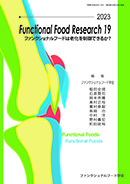Current issue
Displaying 1-22 of 22 articles from this issue
- |<
- <
- 1
- >
- >|
-
Article type: other
2023 Volume 19 Pages 1
Published: October 12, 2023
Released on J-STAGE: February 11, 2024
Download PDF (732K)
-
Article type: editorial
2023 Volume 19 Pages 5-9
Published: October 12, 2023
Released on J-STAGE: February 11, 2024
Download PDF (2015K) -
Article type: review-article
2023 Volume 19 Pages 10-15
Published: October 12, 2023
Released on J-STAGE: February 11, 2024
Download PDF (2936K) -
2023 Volume 19 Pages 16-21
Published: October 12, 2023
Released on J-STAGE: February 11, 2024
Download PDF (1431K) -
Article type: review-article
2023 Volume 19 Pages 22-27
Published: October 12, 2023
Released on J-STAGE: February 11, 2024
Download PDF (2572K) -
Article type: review-article
2023 Volume 19 Pages 28-33
Published: October 12, 2023
Released on J-STAGE: February 11, 2024
Download PDF (2991K) -
Article type: review-article
2023 Volume 19 Pages 34-38
Published: October 12, 2023
Released on J-STAGE: February 11, 2024
Download PDF (1704K) -
Article type: review-article
2023 Volume 19 Pages 39-44
Published: October 12, 2023
Released on J-STAGE: February 11, 2024
Download PDF (1629K) -
Article type: review-article
2023 Volume 19 Pages 45-49
Published: October 12, 2023
Released on J-STAGE: February 11, 2024
Download PDF (2787K) -
Article type: review-article
2023 Volume 19 Pages 50-55
Published: October 12, 2023
Released on J-STAGE: February 11, 2024
Download PDF (1755K)
-
2023 Volume 19 Pages 56-64
Published: October 12, 2023
Released on J-STAGE: February 11, 2024
Download PDF (1960K) -
2023 Volume 19 Pages 65-72
Published: October 12, 2023
Released on J-STAGE: February 11, 2024
Download PDF (1632K) -
2023 Volume 19 Pages 73-83
Published: October 12, 2023
Released on J-STAGE: February 11, 2024
Download PDF (2292K) -
2023 Volume 19 Pages 84-89
Published: October 12, 2023
Released on J-STAGE: February 11, 2024
Download PDF (1863K) -
2023 Volume 19 Pages 90-99
Published: October 12, 2023
Released on J-STAGE: February 11, 2024
Download PDF (1994K) -
2023 Volume 19 Pages 100-111
Published: October 12, 2023
Released on J-STAGE: February 11, 2024
Download PDF (2474K) -
2023 Volume 19 Article ID: ffr22-0705
Published: 2023
Released on J-STAGE: April 17, 2024
Advance online publication: September 15, 2022Download PDF (963K) -
2023 Volume 19 Article ID: ffr23-0113
Published: 2023
Released on J-STAGE: April 17, 2024
Advance online publication: April 20, 2023Download PDF (2245K)
-
Article type: other
2023 Volume 19 Pages 113
Published: October 12, 2023
Released on J-STAGE: February 11, 2024
Download PDF (1286K) -
Article type: oration
2023 Volume 19 Pages 114-121
Published: October 12, 2023
Released on J-STAGE: February 11, 2024
Download PDF (1810K) -
Article type: oration
2023 Volume 19 Pages p122-p129
Published: October 12, 2023
Released on J-STAGE: February 11, 2024
Download PDF (1826K) -
Article type: oration
2023 Volume 19 Pages p130-p136
Published: October 12, 2023
Released on J-STAGE: February 11, 2024
Download PDF (2850K)
- |<
- <
- 1
- >
- >|
